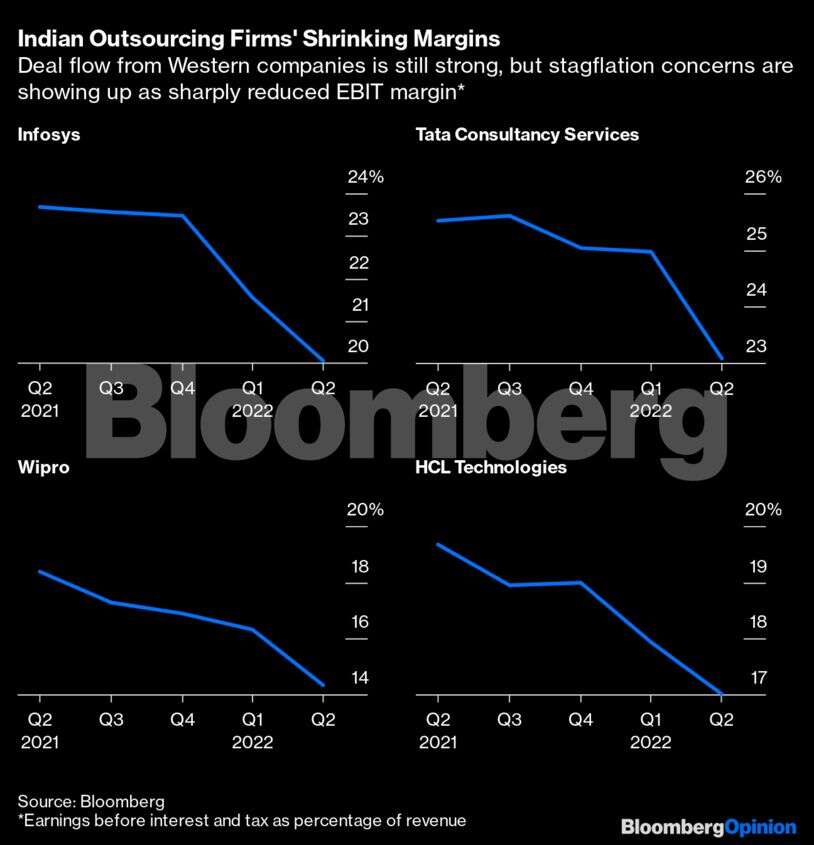
India’s tech industry is ruling out a US recession. Or so you would think from Infosys Ltd.’s cheery forecast of 14% to 16% annual revenue growth, slightly better than what the country’s second-biggest exporter of software services was projecting just three months ago.
The Bengaluru-based firm, which reported its June quarter earnings on Sunday, is considered the industry’s weathervane. If it’s optimistic about orders, then there’s reason to believe that the the deal pipeline isn’t drying up. US and European firms — from banking, manufacturing and retail to health care and utilities — are still entering offshoring contracts, particularly those that will help them automate processes to cut costs.
Evidence of heightened activity is also visible in last quarter’s 12% year-on-year jump in Bengaluru office rents — three times as steep as Shanghai, Singapore or Sydney, according to Knight Frank. In the world’s code-writing capital, information technology drives more than two-fifths of office-space leasing. If the tenants are paying more for space, they must be upbeat about the future.
But is that optimism well-founded? Look closer at the financial results of IT firms, and you’ll see signs of stagflation in plummeting profitability. Infosys managed to boost rupee earnings by just over 3% from a year earlier in the June quarter, even with nearly 24% revenue growth. A 20% EBIT margin — earnings before interest and tax as percentage of revenue — is a 3.6 percentage point drop year on year. In fact, it’s even worse than what the bellwether outsourcing firm was garnering immediately before the pandemic gave a big lift to the business.
At Infosys’s traditional Bengaluru rival, Wipro Ltd., the EBIT margin fell to its lowest since the September 2018 quarter. Partly that was because it signed up 15,000-plus net new employees, including 10,000 fresh graduates in three months through June 30. (Infosys bumped up its headcount by more than 20,000 during the same period.) But then again, competitor HCL Technologies Ltd., which hit the brakes by slashing quarterly net hiring by almost four-fifths to about 2,000, also saw a lower-than-expected EBIT margin of 17%, a multiyear low.
The margin at Tata Consultancy Services Ltd., the biggest Indian IT vendor, was better at 23.1%, but it was still 2.4 percentage points narrower than for the June quarter of 2021. TCS management has indicated that $7 billion to $9 billion worth of quarterly deal wins could be a sustainable rate. That’s “flattish” from a year-on-year growth basis, Nomura says.
Profitability might remain under pressure for the rest of this year — both because of a slowdown in the West, and the way the industry is structured in India. Offshoring is profitable, but the people it employs won’t stay on their jobs forever without onsite postings at client locations and dollar wages. With the pandemic over, travel and visa expenses are adding up. But the Indian vendors will struggle to get paid more — customers will cite the near-7% drop this year in the rupee as a reason to not bump up the dollar price of contracts. The exchange-rate advantage, however, will be insufficient to make up for the rising pressure of rupee costs.
 For one thing, salary increases can’t be skimped on: TCS employs more than 600,000 people, but its attrition rate is almost touching 20%, more than double from a year earlier. Employee retention appears to be even more challenging at Infosys, where attrition surged past 28% in the June quarter. Startups that target India’s local e-commerce or fintech markets compete for the same programmers as the software exporters. While small, private-equity-funded firms are turning cautious about burning cash on payroll, an employers’ market for coding talent is perhaps a story for next year. With India’s domestic inflation rate at 7%, IT services firms have little scope for belt-tightening on wage costs.
For one thing, salary increases can’t be skimped on: TCS employs more than 600,000 people, but its attrition rate is almost touching 20%, more than double from a year earlier. Employee retention appears to be even more challenging at Infosys, where attrition surged past 28% in the June quarter. Startups that target India’s local e-commerce or fintech markets compete for the same programmers as the software exporters. While small, private-equity-funded firms are turning cautious about burning cash on payroll, an employers’ market for coding talent is perhaps a story for next year. With India’s domestic inflation rate at 7%, IT services firms have little scope for belt-tightening on wage costs.
Ultimately, all of them will resort to “pyramiding” to protect their margins. It basically means putting a lot of inexperienced code-writers under an experienced project manager and hoping that the client will still come out happy. But since rookies’ productivity has its limits, the more complicated programming will have to be sub-contracted to smaller vendors. The costs of doing that are rising as well.
The best bet for India’s IT services exporters is to hope that the US economy — their most important market — will avoid a recession; and that customers who ramped up their digital budgets during Covid-19 will keep giving orders. Will they? Clients may continue to see value in cloud computing, analytics, artificial intelligence and even augmented reality, but their “willingness-to-spend will be constrained by their ability-to-spend” because of “earnings pressure from commodity and wage inflation, supply chain challenges, reduced consumer spending power, higher interest rates and likely below-trend growth in Western developed economies,” says Mumbai-based broker Nirmal Bang Securities.
The large consumer tech companies, such as Alphabet Inc. or Meta Platforms Inc., are witnessing a drop in their premium valuations. The more industrial end — writing code for Western corporate customers — won’t be immune, either. India’s Nifty IT Index, which tripled between the onset of Covid-19 in March 2020 and the end of last year, has slipped 27% so far in 2022. Investors aren’t as sanguine about profitability as software exporters are gung-ho about order books. Sooner or later, a US recession will come to Bengaluru, too.